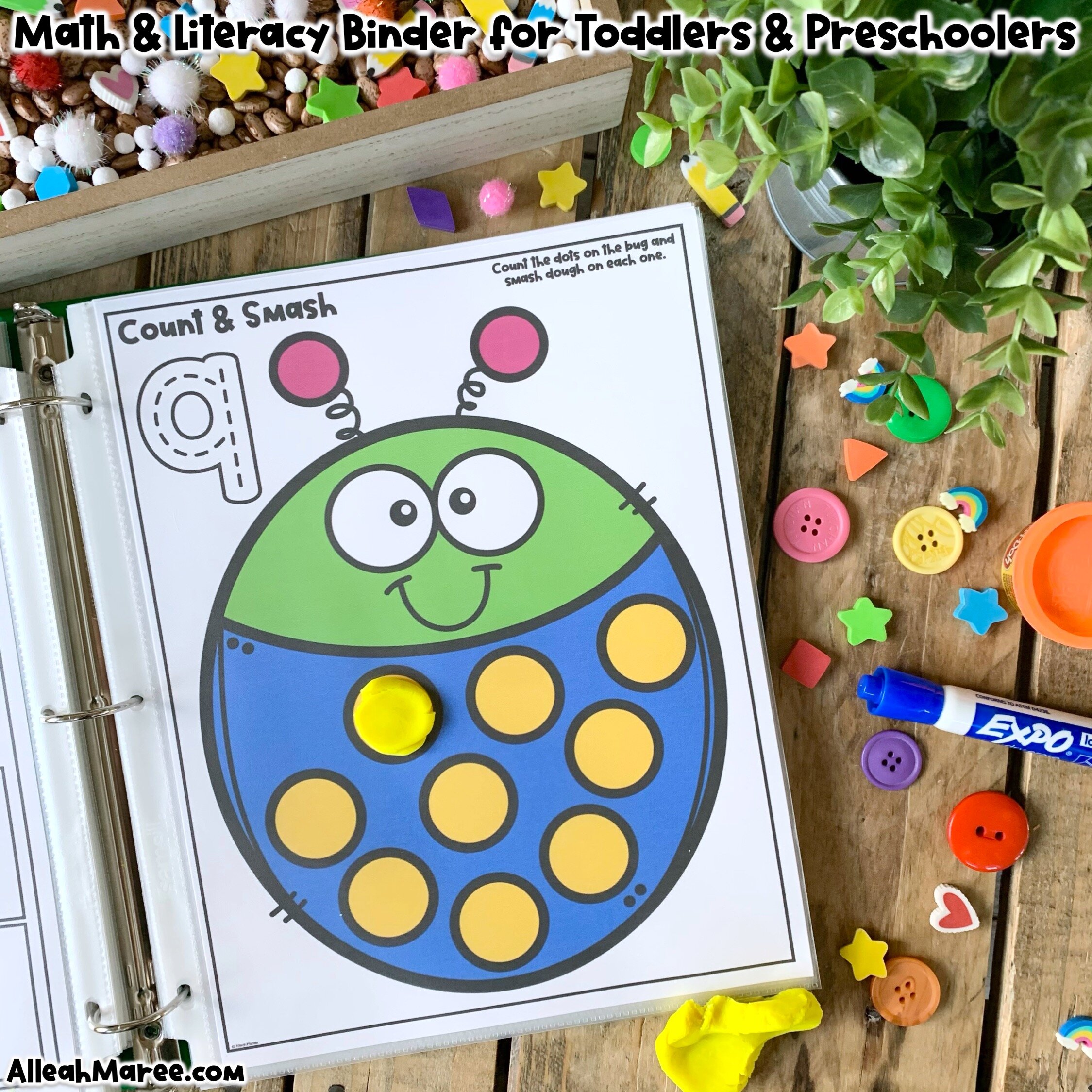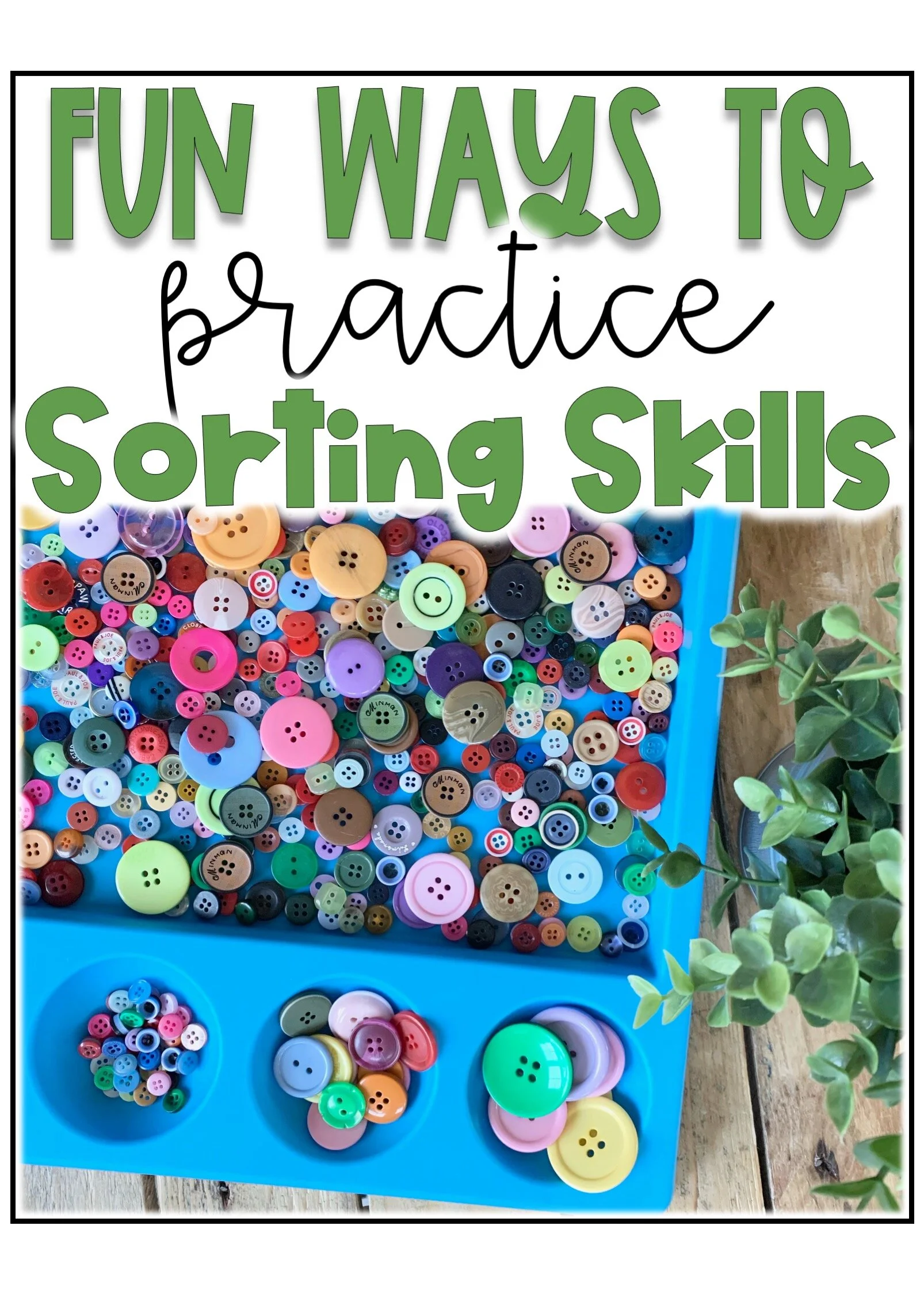Math and Literacy Learning Binder for Toddlers and Preschoolers
If you’re teaching toddlers and preschoolers foundational math and literacy skills, you know it takes a LOT of repetition, variety, and FUN. So, I’ve created a way to include ALL those elements into one simple resource: the math and literacy learning binder for toddler and preschoolers!
Scroll to check out an in-depth peek at ALL the activities currently included in this learning binder, along with some tips and ideas for ways to use them well with your young toddlers to your advanced preschoolers!
** This post contains a few affiliate links. If you purchase any of the products I already personally love and am linking for you, I’ll receive a small percentage of the profit that the website makes from your purchase at no extra cost to you. :) Such a win-win-win! **
Learning all the colors, being able to identify them, and recognize the matching color word are just a few skills that your little ones will eventually need to master. There are TONS of amazing ways to practice colors in real life, like playing “I Spy”, naming colors you see around the house or town, and even just playing with crayons and markers at home together.
So, in the binder, you’ll find a couple ways to practice colors. Your little ones can match the cards provided to the correct color mat, sort the color cards in columns based on their color, or even sort small items they have at home onto the correct mat. You can use pom-poms, mini erasers, buttons, small toys, or even snacks to play with these color sorting boards and reinforce color knowledge with any aged little one. Older learners can practice tracing the color word and writing the color word themselves in each box? Or finding small red items that start with the letter R? You can make these color activities last all the way through kindergarten by adding your own twist on the activities.
For more ideas for learning colors, check out THIS BLOG POST.
Practicing letter names and shapes is an important, foundational literacy skill for young learners. The letter activities included in this binder are super hands-on and work super well for practicing matching and naming capital and lowercase letters. Your little ones can practice matching the letter cards to the letter mats and practice tracing or building the letters with a dry erase markers or small manipulatives. You can extend the learning further by creating the letters with manipulatives or playdough, matching magnetic letters to the mats, or singing along to a letters video or song after completing the activities. There are also alphabet gummies and letter cookies you could have little ones match up to keep them engaged even more! Immersion is a great way to soak up lots of information about a topic, so toss them into those letters any way you want to and make it fun for them.
Check out THIS BLOG POST for even more ideas for learning the letters of the alphabet!
There are a bunch of ways to incorporate fine motor skills into the activities in this learning binder. Your little ones can use a variety of materials to create and represent the letters, numbers, and shapes inside. Dry erase markers to practice tracing, playdough or wikki sticks for creating or representing, snap cubes for building, and tongs to pick up the manipulatives and place them in the correct spots are just a few ideas for ways to practice fine motor skills throughout the entire binder. Manipulating these objects and using them to complete the learning tasks is a great way to strengthen hand muscles and develop fine motor skills without even knowing it. They’re perfect tools to use to blend together learning and playing! You can also incorporate snack foods that are interesting or motivating for your little ones, like goldfish, cereal, or small candies, to practice fine motor skills AND provide an incentive to work hard too. Choose whichever activities are best for your kiddos, organize them into the binder, and let them go to town creating playdough, building with cubes, or learning with whatever manipulatives you choose.
Tracing is a simple way for little ones to start learning how to control their hand movements. These fine motor skills take a lot of muscle control and practice, so using these skills in a variety of ways is a great way to help your little one develop these skills more quickly. The pages included to practice tracing letters, numbers, and a variety of lines can be completed using dry erase markers or in a variety of other ways if your little one isn’t quite ready yet. They can cover the lines’ curves with small manipulatives like mini erasers, use play dough or wikki sticks or pipe cleaners to create the shapes and lines, or they can practice tracing using their fingers!
BEGINNING SOUNDS
Learning letter sounds is another essential literacy skill for little ones. So, even if they’re not quite ready for letter names and sounds independently, these activities are fun to do together to introduce letter sounds. You can hide the letter cards around the room or place them in a sensory bin and have your kiddo choose a card. Then, talk together about what the picture is, what letter the picture starts with, and where they see that letter on the “pick and smash” page or the specific letter page. I’d recommend teaching your toddler the most common sound the letter makes and see if they can copy that sound too! The beginning sounds activities will probably be a VERY guided learning time at the beginning, but as your kiddos start to recognize the way letters look and remember the sounds from hearing them often or singing phonics songs, this sort of activity will get easier.
Need a few other ways to practice the alphabet? Check out this blog post about fun ways to learn the alphabet!
The number identification activities can be completed in a bunch of ways, like most of the activities in this binder. Your preschooler can match the number cards to the mat and say the number’s name out loud, the can trace or build the number and the number word, and/or they can show the number in the box near the bottom. And if your little one is ready for even more, they could write the matching number in the boxes below instead of matching the cards or build the number 4 more ways or using different things. Little ones could also match magnetic numbers to the mat! There are so many different ways to practice math basics with these activities.
The activities included for practicing counting can serve quite a few purposes. Of course, learning and practicing one-to-one correspondence and counting objects is an obvious one, but these activities are also great for practicing number recognition and number formation! If your little one is JUST learning to count, just count together and match the cards to the matching numbers. They can match magnetic numbers to the mat, use their fingers to show the number, or build the number on top of the card with small manipulatives to add to the counting activities.
The shapes activities included in the binder are great for practicing matching, naming, and creating shapes. Your little ones can practice describing the shapes to expand and practice their math vocabulary. You can help those new words stick by connecting the words you’ve read in a book with the words they’re learning in their activity. Can they build the shapes with manipulatives after matching them? Can they identify the color of the shapes? Do they want to draw or trace the shapes with dry erase markers? Want to create them out of playdough or find a shapes video to sing along to? You can extend the learning from these activities in a VARIETY of fun ways!
Having the skills to know the sequence that something happens in is an essential literacy (and life!) skill for little ones. You can practice these sequencing skills by matching the numbers to the page (or placing them in order in the blank squares) and then show the pictures in the correct order that they happen in. There are activities that include 3 steps and 4 steps. Maybe your little one only knows what happens first or what happens last when you first start practicing…and that’s great! Little steps are good steps. :) Whatever level your kids are ready for, practicing describing a sequence of events is a great way to boost comprehension skills and prepare them for more complex skills later on.
You can also practice by asking your little ones what happened first and last in their day or their favorite book, what should come NEXT or FIRST when they’re playing with something, or even just practicing putting numbers or letters in the correct order. Though it may take some practice to understand the concept, you’ll be encouraging them to learn that things usually happen in a certain sequence.
Learning about the seasons and the characteristics of each one that make them unique is a basic science (and life!) skill that little ones start to learn as a very tiny little one. :) We talk all the time about how each season feels, what things we might see or do in that season, and describe the weather based on what season it is too! The seasonal activities included in the toddler and preschool binder are perfect for talking about the way each season feels and the things you might see or do during that season. They go along with books like “Is It Warm Enough for Ice Cream?” and “ All About Weather: A First Weather Book for Kids” and are a great way to introduce the concepts of seasons and weather.
Sorting and categorizing objects and items by size is a math skill that little learners practice naturally a lot of the time! My little guy finds “baby” things and “Daddy” things, which is his way of describing small and large. Haha! :) So, the size sorting activities in this book can be completed with the cards provided OR by sorting objects that your kids have around them anyway. They could sort small, medium, and large crayons or small, medium, and large snacks or other manipulatives you’re using. The skill of comparing sizes is an essential one, but also one that’s simple to practice in every day life. What kinds of things does your little one already sort by size? :)
There are also pages to match baby animals to their mama animals, match animals to their habitats, and sort pictures of different kinds of foods, like fruits, veggies, and treats. Many of these activities include matching skills, sorting skills, or some kind of fine motor skills to complete them, but I’d love to encourage you to be creative and use these in the way that makes sense to your little learners.
Ooh! And one last idea is that you can print out one activity at a time and use them as one-page centers! So, if putting a whole binder together isn’t going to work for your situation, you can have centers for all kinds of skills for toddlers and preschoolers by printing out a mat, the cards, and using whatever manipulatives you have!
I hope these activities gave you some good ideas for ways to help your little ones learn and play at the same time! Please feel free to pop in with questions or ideas you’d like to see added! :)
Until then, happy learning! I’m cheering you on!
Wanna follow me on TPT? CLICK HERE!
Is Instagram more your thing? CLICK HERE!
To peek at my Facebook page, CLICK HERE!




















